Vaccine News Ledger; Third Edition: (Chikungunya) January 5, 2018
Austrian Vaccines Biotech Closes €10M Series C to Stop Global Outbreaks

There's about to be a global outbreak of Chikungunya! Not to worry, though, there's a vaccine in the final phases of trials that will be ready in time for the upcoming global pandemic!
Phew. What a relief!
Wait, what's chikungunya?
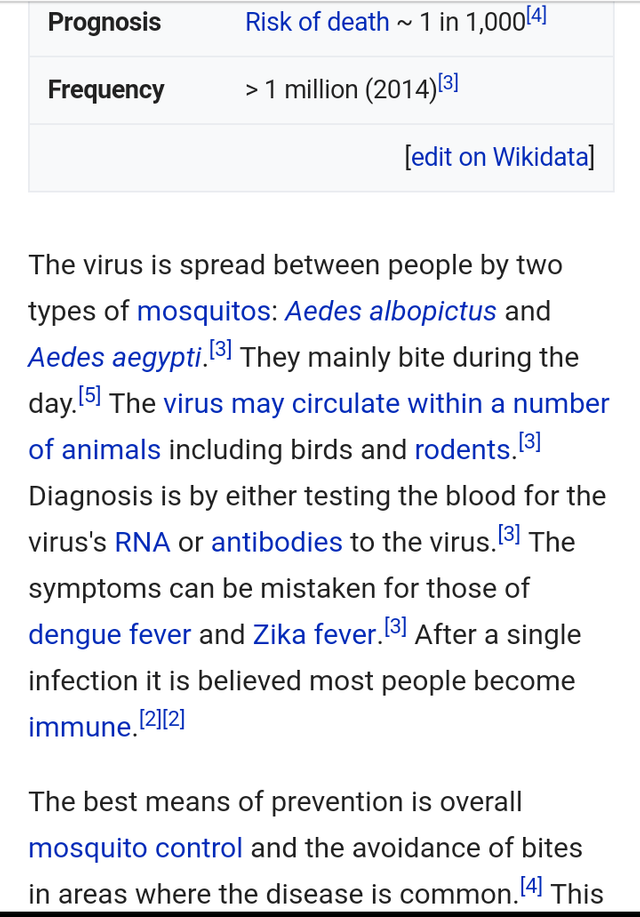
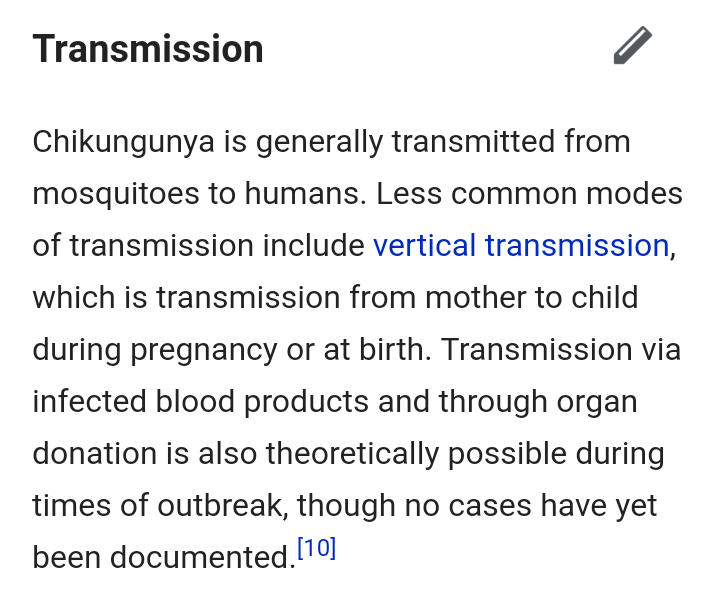
Chikungunya is almost exclusively spread by two types of mosquitos. It grants immunity after a single infection and is easily mistaken for dengue and zika. The best prevention is avoidance of mosquito bites in areas where the disease is common.
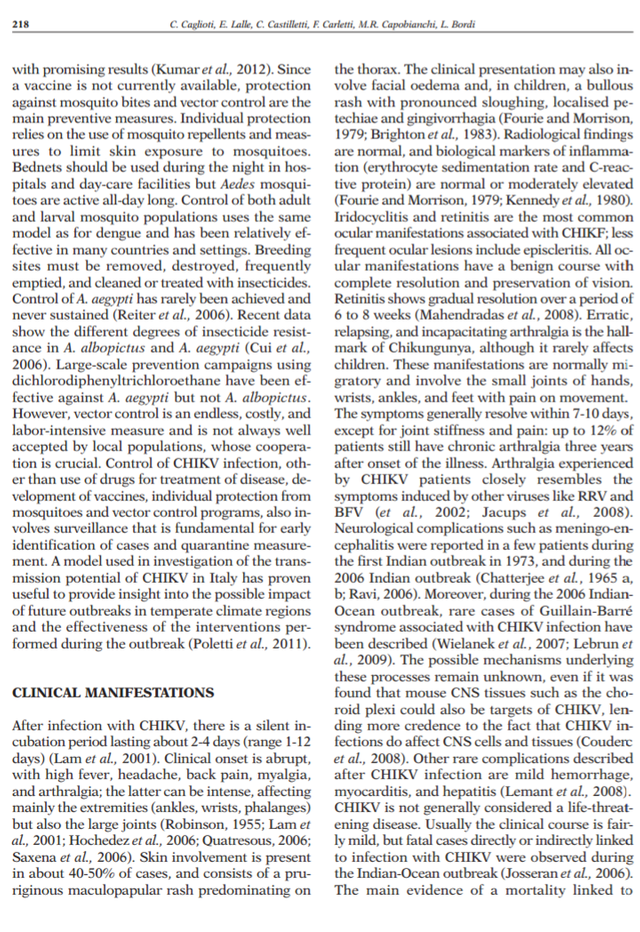
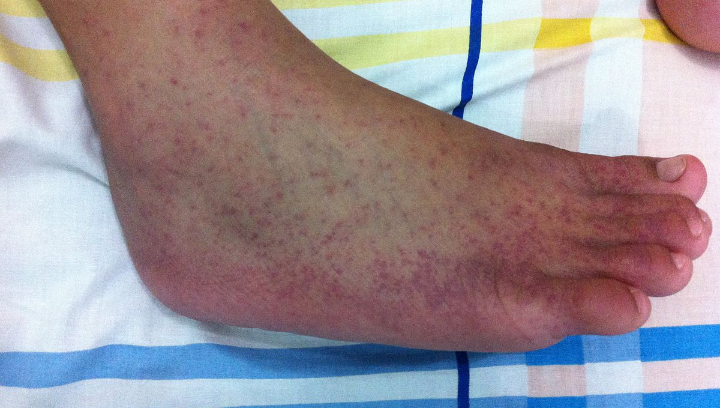
The PubMed overview study on Chikungunya is available to all for free. It states that symptoms generally include an abrupt onset of fever, headache, back pain, muscle pain and joint pain, which can be intense. There's a measles-like rash in about 40-50% of cases, mainly on the thorax. When children are infected, the rash is more blistered and sheds, and they can get facial oedema, (watery fluid collecting in cavities and tissues). Joint pain is rare in children.
The symptoms typically resolve on their own in 7-10 days, as there is no treatment, only medications for comfort and to ease symptoms. Joint pain can linger in up to 12% of the infected, sometimes for up to 3 years
There were two major Indian ocean outbreaks, in 1973 and 2006, where there were reports of GBS and encephalitis, but the study says the underlying reasons are unknown, so it's possible it could not have even been related.

Chikungunya is not considered fatal or deadly. In fact, most cases are mild throughout its course. Mortality rates are extremely low. There were two outbreaks in history where mortality rates were higher than expected, but even they are not considered causal of the disease.
"These differences may be attributed to
many factors (greater disease severity, preexisting
patient conditions, different patient management,
or coincident excess deaths from other causes)
but may also be due to a different efficacy of the
surveillance systems for CHIKF (Chikungunya), that probably
worked poorly in Mauritius and India, leading to
underestimation of the total number of cases
(Fusco et al., 2010). "
Now that we know what this little-known disease is about, let's examine the article. The link is at the top of this article, but I'll repost it here for your convenience.
Themis got 10 million euros, (equivalent to about 12 million U.S dollars), to further this vaccine production.
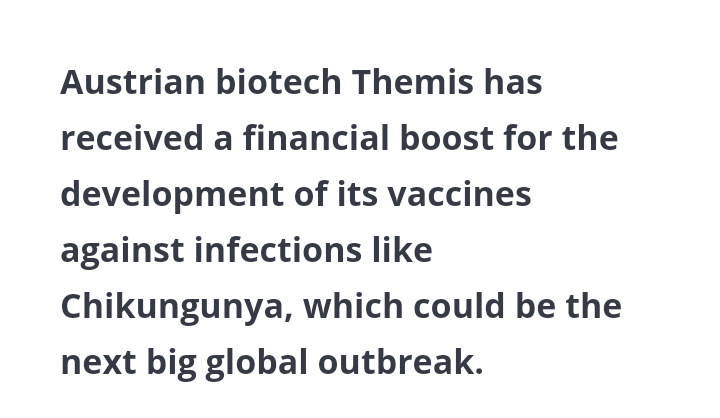
I love this... Every time a vaccine is just about to be finalized, or is ready to go, conveniently, there is, or is going to be, a large outbreak. They are just finishing up this vaccine in time for this mild, non-lethal, seldom heard of disease to be "the next big global outbreak." Which is likely why they got their financing. Very convenient...
The article states that in recent years, the virus has spread to global reaches. This was the map data as of 2012:

So, if it's spread globally since then, let's examine that claim a moment. The Pan American and World Health Organization has put together a set of 4 data charts on global Chikungunya for 2014-2017. (To view the documents on the Pan/WHO site, you must click on the corresponding year, then "number of reported cumulative cases" at the top of the lists...)
Here are all four documents, along with a close up of the notes:
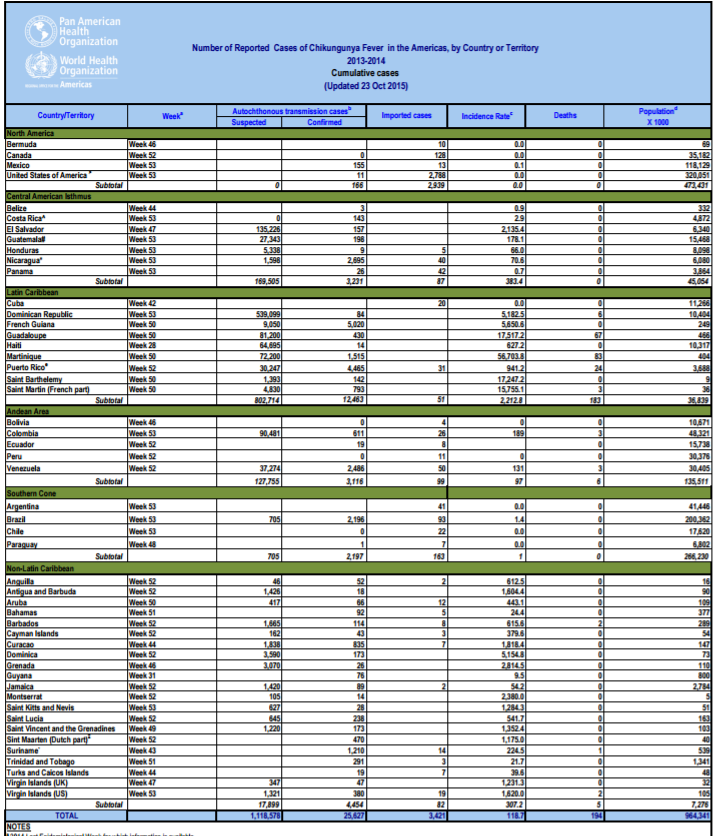
2014
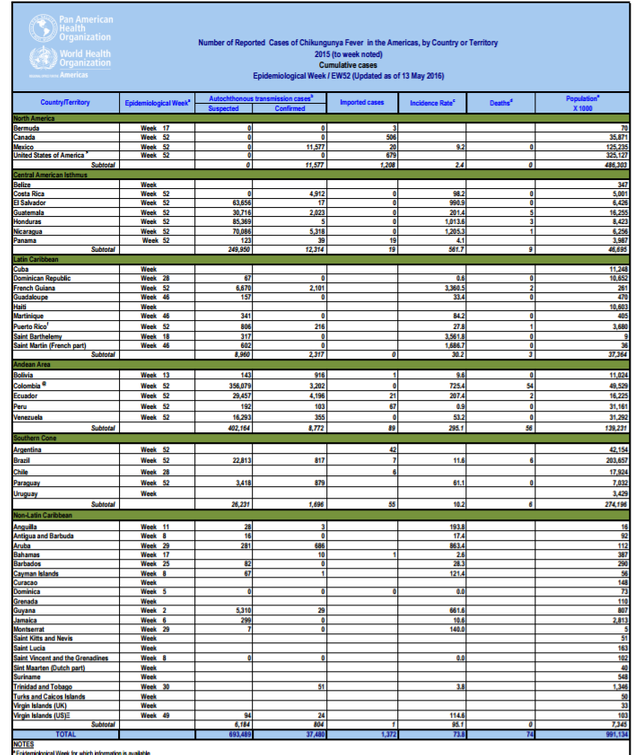
2015
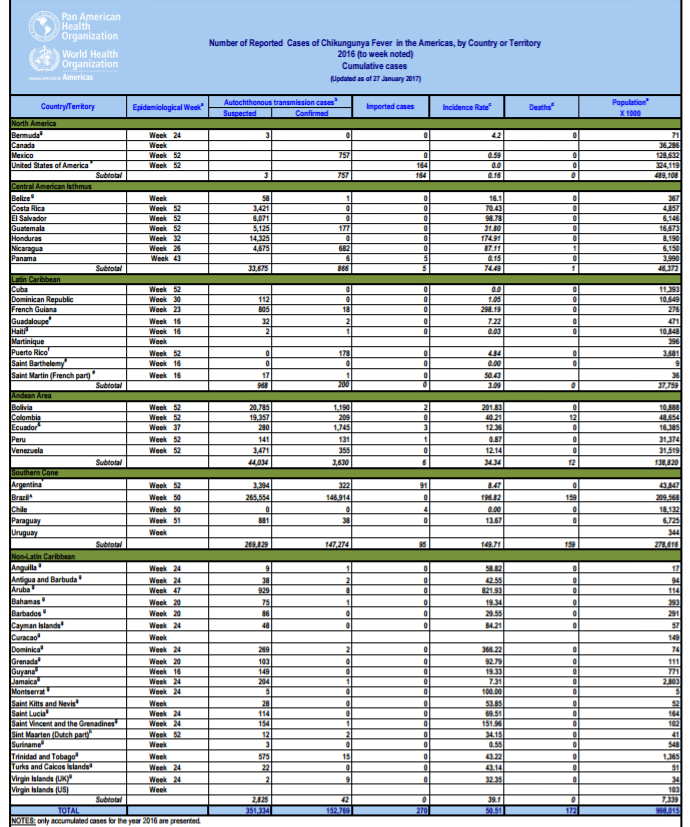
2016
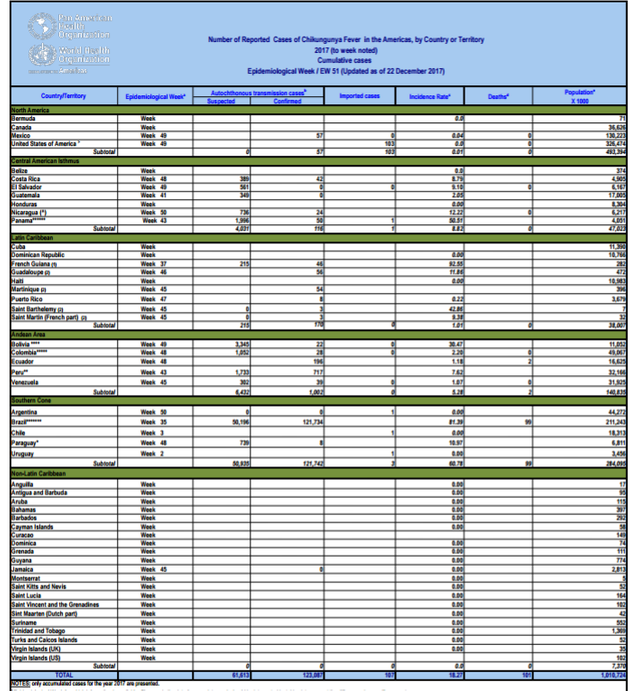
2017

Notes
Let's make some simplified charts for a general overview of key data over the past four years.
North America, (including Canada, America, Bermuda and Mexico):
| Year | Cases | Incidence Rate | Deaths | Population |
|---|---|---|---|---|
| 2014 | 166 | 0.1 out of 100,000 | 0 | 473,431,000 |
| 2015 | 11,577 | 2.4 out of 100,000 | 0 | 486,303,000 |
| 2016 | 757 | 0.16 or of 100,000 | 0 | 489,108,000 |
| 2017 | 57 | 0.01 out of 100,000 | 0 | 493,394,000 |
From 2014-2017, North America has had:
12,557 total cases.
3,139 average annual cases.
2.67 out of 100,000 average annual incidence rate.
No deaths.
Largest incident and death rate data overall:
| Year | Territory | Cases | Rate | Deaths | Population |
|---|---|---|---|---|---|
| 2014 | Latin Caribbean | 12,463 | 2212.8 out of 100,000 | 183 | 36,839,000 |
| 2015 | Central American Isthmus | 12,314 | 561.7 out of 100,000 | 9 | 46,695,000 |
| 2016 | Southern Cone | 147,274 | 149.71 out of 100,000 | 159 | 278,616,000 |
| 2017 | Southern Cone | 121,742 | 60.78 out of 100,000 | 99 | 284,095,000 |
From 2014-2017, the territories that have been hit the hardest has had:
293,793 total cases
73,448 average annual cases.
746 out of 100,000 average annual incidence rate.
450 total deaths.
113 average annual deaths.
Purely because it's my country and neighbouring country...
Canada and the United States of America:
| Year | Country | Cases | Rate | Deaths | Population |
|---|---|---|---|---|---|
| 2014 | Canada | 0 | 0 | 0 | 35,182,000 |
| 2014 | America | 11 | 0.0 out of 100,000 | 0 | 320,951,000 |
| 2015 | Canada | 0 | 0 | 0 | 35,871,000 |
| 2015 | America | 0 | 0 | 0 | 325,127,000 |
| 2016 | Canada | 0 | 0 | 0 | 36,286,000 |
| 2016 | America | 0 | 0 | 0 | 324,119,000 |
| 2017 | Canada | 0 | 0 | 0 | 36,626,000 |
| 2017 | America | 0 | 0 | 0 | 326,474,000 |
From 2014-2017, Canada and America has had:
Well... I don't think I need to crunch those numbers...
All countries included in this data combined:
| Year | Cases | Rate | Deaths | Population |
|---|---|---|---|---|
| 2014 | 25,627 | 118.7 out of 100,000 | 194 | 964,341,000 |
| 2015 | 37,480 | 73.8 out of 100,000 | 74 | 991,134,000 |
| 2016 | 152,769 | 50.51 out of 100,000 | 172 | 998,015,000 |
| 2017 | 123,087 | 18.27 out of 100,000 | 101 | 1,010,724,000 |
From 2014-2017, all countries in this data has had:
338,963 total cases. (0.03% of this data caught Chikungunya over the last 4 years)
84,741 average annual cases.
517.5 out of 100,000 average annual incidence rate.
541 total deaths. (0.2% of cases died over the last 4 years)
135 average annual deaths.
338,963 cases.
If you add imported cases, (5,170), that's 344,133.
Suspected cases alone add up to 2,225,014. (Suspected cases are just having a symptom in an area where the disease is present.)
I was generous with these numbers and took the highest totals from their data.
The averages are actually lower than these numbers, because the 2014 study actually states that it's from 2013 and 2014, but I took the averages from 4 when it should have been 5.
So, I really don't know how they got this:
"Over the last four years, there have been over 1.7 million cases across 45 countries," as this is their data...what they used.
Another blatant lie? (If you can see something I've missed, please, show me my error!) I've always enjoyed and been really good with numbers (math) and graphs, though, so I'm confident that my calculations are correct.
I also don't really see it spreading to a global reach. In fact, last year it actually got better.
Now, in total over the past 4-5 years, only 0.03% of over a billion included in these studies (45 countries) caught confirmed cases of Chikungunya. 0.2% of that 0.03% were fatal. It's killed 541 out of 1,010,724,000 in nearly 5 years. My calculator won't even compute that miniscule percentage of deaths.... And even that number has grace.
If you look at the "deaths" header,
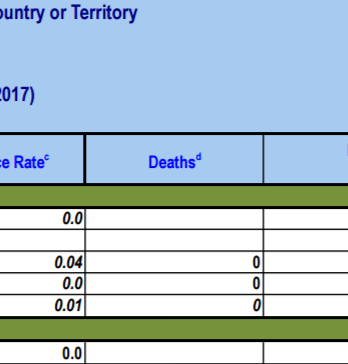
It has a reference. "d".

So the deaths in this data are not even all directly related to this disease. In all WHO data, indirectly related deaths mean that any death that occurs while the patient is sick is counted. If someone is sick and dies in a car crash, it's counted. If their area is bombed while they're sick and they die, it's counted. If they are very elderly and die possibly from natural causes (old age) while they're sick, it's counted. You get the idea. Not all of those deaths are because of the disease.
Most vaccine finances are lobbied using incidence rate and death rates. Since this data is much too insignificant, they don't mention it. Instead, they take the most significant data at the highest possible amount they can scrape together, even adding to it somehow, and present that. They couldn't even mention average annual rates, as those are small as well, so they took all cases from 5 years, combined 2 years into 1 and called it all 4 years, totaled the cases (?) and presented that.
That's how all vaccine researchers do it. They cherry pick the most significant data, omit the rest, and use that to lobby the funds. I'll be pointing this out as I go with this ledger.
The wording is great, too. Mortality is not mentioned, so they say "leaving patients with sudden fever and severe joint and muscle pain, potentially causing debilitating long-term effects." Note the use of the word "debilitating". This paints a picture of this disease crippling it's hosts, when, in reality, it only gives up to 12% of hosts chronic joint pain lasting longer than a week. Maybe 12% of the 0.03% that actually confirm catching the disease.
These statistically insignificant numbers are what granted them over $12m USD. Money like that, especially for other vaccines, comes from our pockets. I don't even think the numbers matter, if government hears "vaccine", they pay.
I'll be keeping an eye out for mention of Chikungunya in the news in the next little while. Interested to see how this plays out!
For more pieces like this, be sure to check out the previous editions of the Vaccine News Ledger!
- Second Edition: December 29, 2017 Cholera Outbreaks
- First Edition: December 31, 2017
Women More Active In Online Anti-Vaxxers’ Groups: Study
Yeah same old same old, start spreading fear, about this disease how it affects all ages and make sure to highlight the very few cases when it has been fatal, mention debilitating and when most of the population feel at risk let the pharmaceutical companies swoop in to save the day with their vaccine. Thanks for sharing @mommanatural, will be keeping an ear out for this propaganda.